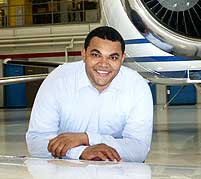
OCTOBER 2006: The Airline Group of the International Federation of Operational Research Societies has presented PARTNER lead investigator and former director John-Paul Clarke with its "Best Innovation" in Airline Operations Research award for a paper he presented on October 2 at the organization’s annual symposium in Rome. Clarke’s paper was titled "Continuous Descent Arrivals: Flight Procedures that Reduce Fuel Burn.”
According to Tim Jacobs of American Airlines, immediate past-president of AGIFORS and technical chair of the 2006 Symposium, Clarke was deemed by the delegates to have made the technical contribution which best exemplified the development and successful exploitation of a novel idea. The delegates represent airlines from around the world.
Professor John-Paul Clarke of Georgia Tech's Controlled Descent Arrival project facilitates both quieter aircraft landing approaches and fuel savings. (W. Litant photo) |
 |
John-Paul Clarke is an associate professor in the Georgia Institute of Technology School of Aerospace Engineering. He is the lead investigator for both PARTNER Project 4, Continuous Descent Arrival, and Project 5, En Route Traffic Optimization to Reduce Environmental Impact.
Continuous Descent Arrival, also referred to as Continuous Descent Approach, was developed as a PARTNER research project. Through both simulation and flight demonstration tests, CDA has proven to be highly advantageous over conventional “dive-and-drive” arrival and approach procedures. These advantages provide ample motivation for research efforts to further develop CDA for implementation in low-density through high-density traffic. The environmental and economic benefits of CDA were demonstrated by PARTNER researchers in flight tests at Louisville International Airport in 2002 and 2004. From the environmental perspective, there are significant reductions in noise (due to reductions in thrust and a higher average altitude) and emissions (due to reductions in thrust and a higher average speed). From the economic viewpoint, there are significant fuel and flight time savings (due to reductions in thrust and a higher average speed) as well as the potential to meet or exceed current runway throughput without the need to vector aircraft. A report on the CDA research is available for download (.pdf 2.9MB).
AGIFORS is a professional society dedicated to the advancement and application of Operational Research within the airline industry. Members are operational research professionals employed by civil airlines and related industries, and correspondents interested in the application of operational research to aviation problems.